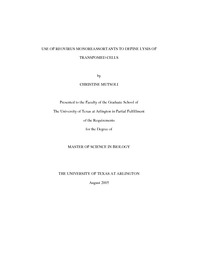
ATTENTION: The works hosted here are being migrated to a new repository that will consolidate resources, improve discoverability, and better show UTA's research impact on the global community. We will update authors as the migration progresses. Please see MavMatrix for more information.
Show simple item record
| dc.contributor.author | Mutsoli, Christine Nora | en_US |
| dc.date.accessioned | 2007-08-23T01:56:34Z | |
| dc.date.available | 2007-08-23T01:56:34Z | |
| dc.date.issued | 2007-08-23T01:56:34Z | |
| dc.date.submitted | August 2005 | en_US |
| dc.identifier.other | DISS-1078 | en_US |
| dc.identifier.uri | http://hdl.handle.net/10106/374 | |
| dc.description.abstract | Reovirus is known to selectively destroy transformed cells while establishing a persistent infection in normal cells. For this study the transformed cell lines used were L929, WI-38 VA13 2RA, T1, N1, and MYC-3. Additionally, the normal cells WI-38 and MMEC were used to examine differential sensitivity to reovirus serotypes 1, 2, and 3. Reovirus is able to replicate efficiently in L929 cells because it induces a transition from capped to uncapped translation of viral mRNA. Reovirus maintains a persistent infection in WI-38 cells, but lyses WI-38 VA13 2RA cells. Reovirus has also been demonstrated to lyse and produce more virus per cell in N1 and MYC-3 cells than MMEC cells. However, the virus does not lyse T1 cells efficiently. Monoreassortant viruses containing nine genes from serotype one and one gene from serotype three mapped the genes responsible for this differential sensitivity to the S3 and S4 genes. | en_US |
| dc.description.sponsorship | Roner, Michael | en_US |
| dc.language.iso | EN | en_US |
| dc.publisher | Biology | en_US |
| dc.title | Use Of Reovirus Monoreassortants To Define Lysis Of Transfomed Cells | en_US |
| dc.type | M.S. | en_US |
| dc.contributor.committeeChair | Roner, Michael | en_US |
| dc.degree.department | Biology | en_US |
| dc.degree.discipline | Biology | en_US |
| dc.degree.grantor | University of Texas at Arlington | en_US |
| dc.degree.level | masters | en_US |
| dc.degree.name | M.S. | en_US |
| dc.identifier.externalLink | https://www.uta.edu/ra/real/editprofile.php?onlyview=1&pid=36 | |
| dc.identifier.externalLinkDescription | Link to Research Profiles | |
Files in this item
- Name:
- umi-uta-1078.pdf
- Size:
- 5.101Mb
- Format:
- PDF
This item appears in the following Collection(s)
Show simple item record


